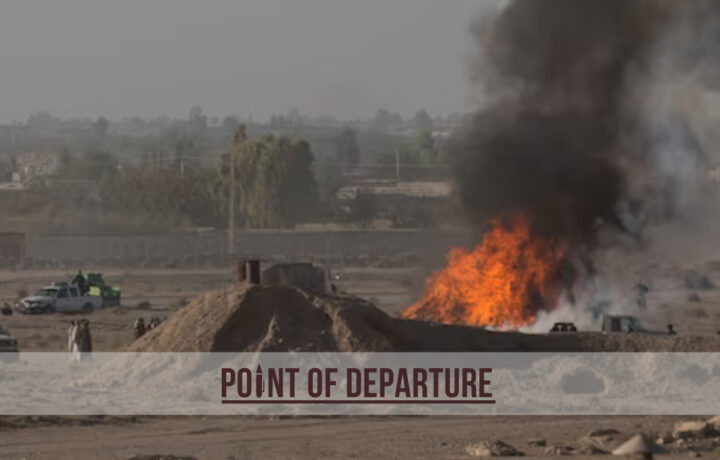“Napalm, son. Nothing else in the world smells like that. I love the smell of napalm in the morning… Smelled like… victory.” – Lt. Col. Bill Kilgore, Apocalypse Now
In the early days of May 1991, I was marshalled with the rest of my battalion in a parking garage in King Fahd International Airport outside Dammam, where we had spent much of the past two weeks. Redeployment had been eight months in coming and I was eager to return home and reunite with my young family. The smell of diesel fumes in the air told me everything I needed to know: the buses had arrived, and we would soon be leaving our concrete confines.
Like many others that day, I packed a few mementos of our time on the Arabian Peninsula: a small acrylic oil barrel marked “Dammam No. 7,” a coffee mug from Arabian Helicopters, and a wall clock that used eastern Arabic numerals. Thirty years later, those keepsakes remain in my office as reminders of another time.
But, as time passed, I realized that I had brought something else back, as well. At first, it seemed like a lingering cold: a runny nose and post-nasal drip, and the occasional sinus infection. I wrote it off as a change in environment and didn’t give a second thought to the smoke from the oil fires or the powerful sandstorms that blasted us with every conceivable pollutant in the region. Even when the specter of Gulf War Syndrome loomed over many veterans, I just blew my nose and powered on. At least I didn’t have cancer.
When I returned for a second invasion of Iraq in 2003, I barely noticed the change. As springtime came to Iraq, I realized that my sinuses were clear again. But, when we redeployed the following year, my new normal was back. This cycle continued through my last tour in Iraq in 2012: my sinuses would clear while I was in country, but regress – and get slightly worse – with every redeployment. The Department of Veteran Affairs acknowledged my chronic sinusitis during my retirement physical but didn’t consider it severe enough to warrant a disability rating.
The Burn Pit Registry
As with many other veterans, my condition worsened over time. A runny nose and post-nasal drip evolved into regular sinus infections that were accompanied by headaches and dizziness. I appealed my initial disability rating from the VA, but after lingering for a year was denied. So, when they established the Airborne Hazards and Open Burn Pit registry in 2014, it seemed like the logical next step.
For anyone who’s served in that part of the world, it’s almost inevitable that you were exposed to some form of toxin. Whether it was particulate matter in the air, contaminants in the ubiquitous dust and dirt, or the end result of people throwing things into burn pits that were never meant to be burned, you were probably exposed to something that is living its best life inside your body somewhere.
Putting your name on the Burn Pit registry is quick and easy. Even if you don’t have any health issues that you’re aware of, doing so protects you in the event those issues manifest later in life. The VA has spent years mapping out the locations of problematic burn pits, and connecting your wartime service to one of those locations is a (relatively) quick process.
The PACT ACT
When Congressman Mark Takano introduced the Honoring our Promise to Address Comprehensive Toxics (PACT) Act on June 17, 2021, I kept my expectations low. With the long ordeal that Vietnam veterans faced with exposure to Agent Orange and knowing the 78% of disability claims for burn pit exposure had been denied, that seemed like the right approach. Congress had (and continues to have) enough problems passing an annual budget, so I assumed the likelihood that the PACT Act would pass was low.
I was wrong. After some obligatory political grandstanding, the bill passed on August 2, 2022, and was signed into law eight days later.
The law, which extended VA health care and benefits for veterans exposed to toxins ranging from Agent Orange to the burn pits, identified more than 20 presumptive—meaning the VA automatically assumes a service connection—conditions tied to exposure. This was significant. Traditionally, veterans filing claims had to prove a service connection; under the PACT Act, that’s no longer the case. The list of presumptive conditions was broad, including a number of cancers and illnesses ranging from asthma and bronchitis to emphysema and pulmonary fibrosis. And chronic sinusitis.
With that knowledge in hand, I filed a PACT Act claim late last spring. My expectations were still low, but the process took minutes, and I assumed that the worst news I would hear was “no.” The VA was quick to acknowledge my claim and after a couple of months, scheduled me for a follow-up appointment with a medical provider. The appointment was brief, focused on confirming changes to my medical condition, and the VA covered the cost of travel (a pleasant surprise). I left that appointment with my expectations unchanged, but I was intent on seeing the process through.
So, when a letter arrived from the VA in November notifying me of a change to the rating for my sinusitis, I was more than a little surprised. They delivered as promised. The entire process took just around six months and was entirely painless, probably made even easier by the fact that toxic exposure was already confirmed and the medical condition well documented. It didn’t change the fact that my nose still runs constantly, and it won’t prevent sinus infections, but the acknowledgment was meaningful.
When I finished reading the letter, it felt a little like getting through CIF without having your canteen returned. I felt relieved. I felt seen. And, knowing what our predecessors went through over the whole Agent Orange debacle, I felt satisfied. I can’t smell victory, but I know it when I see it.




